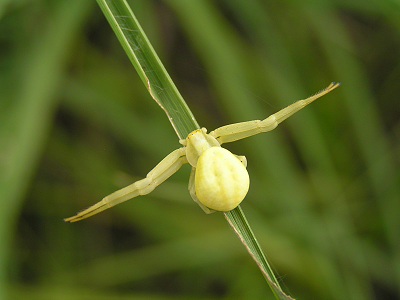 2006
2006
 2008
2008
 2010
2010
 2012
2012
 2014
2014



 |
Ticks and other masters of ambushes
‘Hard ticks (Ixodida: Ixodidae) as potential reservoirs and vectors of tick-borne diseases in selected recreational areas of Upper Silesia’
Piotr Cuber – author of photographs / project manager Dangerous charm, flower crab spider Misumena vatia, Boruszowice, 04.07.2009 Hide and seek, common scorpionfly Panorpa communis, Włodowice, 04.06.2010 |

|
Description popularizing the research project
Not such a long time ago, mosquitoes could ruin your holidays in a forest or at lakes. They left memories worse than the cloudy sky, rain or even their cumbersome company. Their unbearable buzzing could ruin an evening fire and before you went to sleep, you had to fight an unequal battle against the bloodthirsty beasts ignoring even the smartest mosquito nets. Veterans of the battles exchanged ideas how to repel them: from taking vitamin B to aerosols and candles which were to discourage the insects from approaching holidaymakers. Reminders of the holidays with mosquitoes lasted until the last itchy spot had healed. Yet for some years, mosquitoes have not been as cumbersome as they were before. The unpleasant buzzing and a few-day-long itch is nothing when compared with a new, much more serious danger. As we become more and more aware of the threat posed by ticks and their saliva, they loom large in nature lovers’ mind. Many of them have already abandoned forests and meadows in fear of boreliosis, tick-borne encephalitis and other diseases spread by the tiny and sneaky arthropods. A mosquito attack is easier to predict and prevent, thanks to the unbearable buzzing. Ticks ambush their prey, without a warning, unexpectedly. It is also easy to detect a mosquito bite. In case of a tick bite the animal is usually well-anchored in the prey’s body as a fragment of its skin was anaesthetized prior to the attack. A meadow smelling of flowers, humid microclimate of willows on the riverbank, or cool shade in the forest hides legions of lurking expert ambushers, ticks and other predators, fortunately harmless for humans, spiders and scorpionflies. For many holidaymakers consequences of tick-borne diseases are sickening. They miss the familiar buzz of mosquitoes. They, in contrast to the ticks, can make quite nice holiday background music.
Abstract
Hard ticks (Ixodidae) is an interesting group of arthropods linking research problems from many different fields of knowledge. This is due to the parasitic nature of these animals. Ticks are vectors (carriers) of numerous microorganisms. The study was conducted within the framework of the dissertation performed at the Department of Parasitology, School of Pharmacy and Laboratory Medicine, Medical University of Silesia in Katowice. The aim and goals of these studies were as follows, among others: investigate the fauna of the region of Silesia and certain tick-borne diseases (Lyme disease, anaplasmosis, babesiosis and tick-borne encephalitis), determine the degree of exposure of local people and tourists to ticks and the abovementioned diseases. Materials and methods. The total number of 41 sites was selected for tick collection with flagging method. In addition, ticks were collected directly from certain hosts (wild animals, pets and humans) in cooperation with hunters, game purchasing and distribution points, medical and veterinary clinics. The following methods of molecular biology were applied to detect the presence of pathogens in ticks: PCR (using the appropriate primers), Real-time PCR, PCR-RFLP, nested PCR, pyrosequencing and direct sequencing. Results. A total number of 18,499 individuals of castor bean tick was collected, 130 specimens of hedgehog tick and 3 specimens of meadow tick. Only specimens of the first mentioned species of tick were randomly selected for molecular studies. The presence of all four pathogens was confirmed, but with varying frequency. Lyme disease spirochetes prevalence in investigated ticks was approximately 13%, anaplasmosis rickettsiae 20.5%, babesiosis protozoa 3%, and tick-borne encephalitis virus 0.11%. This indicates various level of human exposure to these diseases, which is also dependent on the activity and population density of ticks in particular environment.
Patronat honorowy
Leszek Jodliński
Dyrektor Muzeum Śląskiego w Katowicach
Zygmunt Łukaszczyk
Wojewoda Śląski
Jan Malicki
Biblioteka Śląska
Piotr Uszok
Prezydent Katowic
Adam Matusiewicz
Marszałek Województwa Śląskiego















